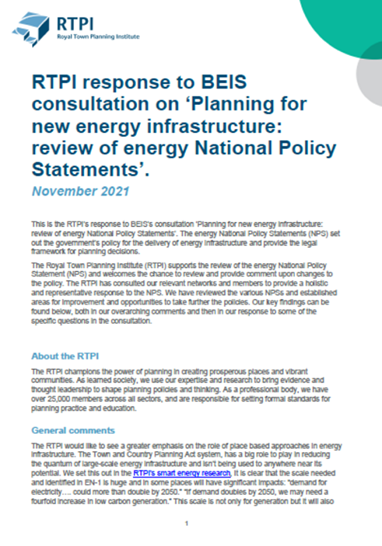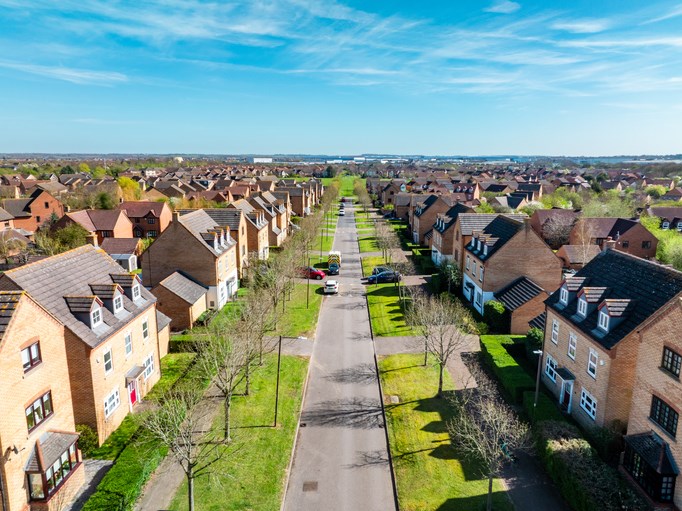November 2021
 This is the RTPI’s response to BEIS’s consultation ‘Planning for new energy infrastructure: review of energy National Policy Statements’. The energy National Policy Statements (NPS) set out the government’s policy for the delivery of energy infrastructure and provide the legal framework for planning decisions.
This is the RTPI’s response to BEIS’s consultation ‘Planning for new energy infrastructure: review of energy National Policy Statements’. The energy National Policy Statements (NPS) set out the government’s policy for the delivery of energy infrastructure and provide the legal framework for planning decisions.
The Royal Town Planning Institute (RTPI) supports the review of the energy National Policy Statement (NPS) and welcomes the chance to review and provide comment upon changes to the policy. The RTPI has consulted our relevant networks and members to provide a holistic and representative response to the NPS. We have reviewed the various NPSs and established areas for improvement and opportunities to take further the policies. Our key findings can be found below, both in our overarching comments and then in our response to some of the specific questions in the consultation.
About the RTPI
The RTPI champions the power of planning in creating prosperous places and vibrant communities. As learned society, we use our expertise and research to bring evidence and thought leadership to shape planning policies and thinking. As a professional body, we have over 25,000 members across all sectors, and are responsible for setting formal standards for planning practice and education.
Read the RTPI's full response below or download it in PDF here.
General comments
The RTPI would like to see a greater emphasis on the role of place based approaches in energy infrastructure. The Town and Country Planning Act system, has a big role to play in reducing the quantum of large-scale energy infrastructure and isn’t being used to anywhere near its potential. We set this out in the RTPI's smart energy research, It is clear that the scale needed and identified in EN-1 is huge and in some places will have significant impacts: “demand for electricity…. could more than double by 2050.” “If demand doubles by 2050, we may need a fourfold increase in low carbon generation.” This scale is not only for generation but it will also need to be replicated in the energy transmission network as well, with National Grid ESO forecasting that over the next decade the onshore transmission network will require significant reinforcement throughout the UK.
Given the required speed and scale of these developments to our existing energy infrastructure there is a real risk that appropriate place-based approaches will not be the priority given the timescales that are currently being enforced. Project Speed has moved the rate at which projects can be planned and completed to the forefront of the conversation, however there is a still a clear need to balance the local impact of projects against the national need for them. The drastic increases to energy generation and transmission will undoubtedly have a knock-on effect on the landscapes across the UK. Consequently, we would welcome a greater focus upon the small-scale projects below the threshold, which would help to mitigate the adverse effects of the increased demand for energy generation and transmission.
This could include: “a doubling of north-south power transfer capacity due to increased wind generation in Scotland; substantial reinforcement in the Midlands to accommodate increased power flows from Scotland and the North of England; substantial reinforcement in London and the South of England to allow for Europe-bound export of excess wind generation from Scotland and the North of England; and substantial reinforcement in East Anglia to handle increased power flows from offshore wind generation.”
There is further concern over the absence of any national spatial strategy in relation to the existing projects. This means that projects will only be considered in relation to the overall demand total and not in relation to where new demand may arise or where transmission capacity exists both now and in the future. As a result of this, the omission of an overarching national spatial strategy creates a siloed approach to projects and forgoes the potential benefits, efficiencies and economies of scale that could be gained through a more holistic approach. Whilst the NPS does acknowledge the need to ‘break down the siloes that have traditionally existed’ it does not provide any detail or indication to how this would be done.
In practical terms, this will provide challenges in the implementation of the NPS at key stages of the process, including initial applications, decision making and appeals, as no hierarchy of policy has been provided. In its goals to form a collaborative approach between different sectors, the NPS should make reference to wider government policy, such as ‘The Road to Zero’ or the ‘Net Zero Strategy’. Both alternative policy papers provide a stronger case for decarbonisation of the UK, as well as more depth in their explanation of how the government intend to achieve these goals.
The absence of a national spatial strategy is also seen in the Environmental Assessment and subsequent topic of Biodiversity Net Gain. We would welcome a more ambitious and cooperative approach to the Environmental Assessment and Biodiversity Net Gain, which placed planning and net gains at the centre.
Whilst EN-1 does acknowledge the wide range of renewable energy generation technologies that will be required to reach net zero emissions, it does not provide support for onshore wind or tidal range projects. The omission of these technologies is concerning and will likely place a greater reliance and dependence upon technologies such as offshore wind. By doing this, the government are failing to secure and diversify the energy supply throughout the UK. Aside from offshore wind, the targets for both solar and floating wind are not as ambitious as they could be. As a result of this, we would recommend that the NPS focuses upon a broader range of renewable technologies that engrain both diversity and security into the UK’s energy supply.
We welcome the approach of the government and the revised NPS in the removal of coal and oil-firing energy generation from the future electricity generation mix, however a preference for alternative generation technologies is not explicitly provided. This could leave investors with doubts which will inevitably delay investment plans and should be rectified to make a significant commitment towards Net Zero.
Questions
Question 1a: Does the draft Overarching Energy National Policy Statement (EN-1) provide suitable information to those engaged in the process for development consent (e.g. the Secretary of State, the Planning Inspectorate, applicants) for nationally significant energy infrastructure on the government’s energy and climate policy (Part 2)?
We support the ambitions outlined in the government’s energy and climate policy (Part 2) however feel that they do not go far enough in attempting to tackle the governments overarching objectives. The NPS still siloes its key topics and policy areas, and whilst the paper does acknowledge the need to ‘break down the siloes that have traditionally existed’ the NPS does not detail how this will be achieved. Consequently, the NPS fails to adopt a holistic and cooperative approach to both planning and energy infrastructure which would help link energy projects to wider developments and infrastructure projects throughout the UK, benefiting from economies of scale and mitigating the negative impacts of these projects.
Question 1b: Does the draft Overarching Energy National Policy Statement (EN-1) provide suitable information to those engaged in the process for development consent (e.g. the Secretary of State, the Planning Inspectorate, applicants) for nationally significant energy infrastructure on the need and urgency for certain types of energy infrastructure (Part 3)?
We welcome the approach of the government and the revised NPS in the removal of coal and oil-firing energy generation from the future electricity generation mix, however we are concerned at the failure to of the NPS to provide a clear preference for alternative generation technologies. Whilst it is assumed that there is a preference for renewable energy generation, the lack of clarity is concerning and does not provide a clear direction for investors and the industry as a whole.
Whilst EN-1 Part 3 does outline which technologies are proven to be viable as well as those which may be viable in the future, there are some notable omissions with onshore wind and tidal range projects being overlooked. The NPs fails to deliver the diversity of technologies that would help to build security into our energy generation.
The government clearly outlines the urgency of the need to shift to net-zero and the impact on the climate, however the urgency of putting in alternative types of energy infrastructure is sadly not provided.
Question 1c: Does the draft Overarching Energy National Policy Statement (EN-1) provide suitable information to those engaged in the process for development consent (e.g. the Secretary of State, the Planning Inspectorate, applicants) for nationally significant energy infrastructure to inform decision making?
The NPS states that the Secretary of State is to assess all applications for development consents of those covered by the NPS on the basis that the government has demonstrated a need for these technologies, yet there is no evidence of wider considerations for the long-term goals of the government. For example, there are no inclusions of a route for decision making to reduce the requirement of remaining fossil fuels and there is no indication as to the scale and variety of projects that will be required. Without these clear roadmaps and policies, decision making will be made on a case by case basis that lacks the structure and long term vision that is required to deliver net zero emissions.
Question 1d: Does the draft Overarching Energy National Policy Statement (EN-1) provide suitable information to those engaged in the process for development consent (e.g. the Secretary of State, the Planning Inspectorate, applicants) for nationally significant energy infrastructure to inform examinations?
The lack of clarity and joined up thinking mentioned above will likely impact concise decision making at examinations and as such is likely to result in third party challenges and investor concern. This will likely have a knock on effect upon the movement away from traditional fossil fuels to alternatives such as hydrogen, wind, wave and solar.
Question 2: Do you agree with the amendments made to EN-1 Part 4 on assessment principles, including new guidance on the marine environment, and biodiversity and net gain?
EN-1 Part 4 provides a clear overarching assessment of the principles in which decision making should align when decision applications. Overall, we support the increased focus and potential protection of marine environment and biodiversity net gain, however the inclusion of these as ‘good practice’ rather than a mandatory requirement is concerning. We would welcome a greater commitment to the marine environment and biodiversity net gain. As raised previously, the scale of need identified in EN-1 is hugely significant, and with this level of development there will be adverse effects on landscapes and the environment. If planning and place-making were to play a greater role in EN-1 then these issues could be mitigated with a particular focus upon biodiversity net gain and the protection of the marine environment.
Paragraph 4.1.5 states that ‘other matters the Secretary of State ‘may’ consider both important and relevant to their decision-making may include Development Plan documents or other documents in the Local Development Framework’. We would propose that this would be better phrased as ‘should’ as this infers that greater consideration will be given the Local Plans and views of local planning authorities, which in turn, should result in less opposition to potential development, which has been experienced through recent planning applications, as SoS decisions could be phrased to be in-line with the energy needs of local communities, as well as nationally. The use of ‘should’ would also better align para 4.1.5 with para 4.1.6 which places increased emphasis on the significance of Development Plans and the ‘plan led system’.
Question 3: Do you agree with the amendments made to EN-1 Part 5 on the generic impacts of new energy infrastructure?
We welcome a significant proportion of the amendments made to EN-1 Part 5, including, Air quality and Emissions; Ancient Woodland and Veteran Trees, SSSI’s and more. We also support the encouragement for applicants to “consider protective measures to control the risk of pollution to groundwater beyond those outlined in Water Resource Management Plans”. We recognise the merit of these amendments and support their inclusion in an attempt to broaden the understanding of the impacts of energy infrastructure. We would encourage the NPS to take this further and incorporate a place-making approach to this, helping to bring together projects and mitigate their potential effects on the environment.
Question 5: Do you agree that the amendments to EN-2 (in combination with EN-1) provide clear planning policy to support the government’s position on the use of fossil fuels in electricity generation and the phase out of coal and large-scale oil?
The amendments to EN-2 in combination with EN-1 show the government’s clear position on the use of fossil fuels in electricity generation and the phasing out of coal and large-scale oil. However, EN-2 offers no understanding on which of the remaining natural gas-fired electricity generation methods would be the preferred approach moving forward. The planning policy also fails to place any requirements for natural gas-fired electricity generating infrastructure to reduce its carbon emissions. Whilst we welcome the phasing out of coal and large-scale oil, the lack of direction for natural gas-fired electricity generation is concerning and does not currently contribute towards the goal of net zero emissions.
Question 10: Do you agree with the new guidance added to EN-3 on pumped hydro storage?
We welcome the specific section upon pumped-hydro storage and support its inclusion.
Question 12: Do you agree with the new guidance added to EN-3 on tidal stream energy?
We welcome the inclusion of Tidal Stream Energy, however we would like to express our concerns that this is limited to Tidal Stream projects. This consequently neglects Tidal Rage projects such as the Swansea Lagoon which could help to diversify renewable energy generation and further contribute towards decarbonising energy production throughout the UK.
Question 20: Do you agree with the new guidance added to EN-5 incentivising more coordination in the design and delivery of electricity transmission infrastructure associated with offshore wind?
We strongly welcome the governments approach in terms of increasing the number of co-ordinated offshore transmission sites in place of the currently preferred radial offshore transmission sites. By reducing the number of radial sites there is a direct reduction in the number of applications which would need to be considered and could therefore help to speed up the application process and eventual delivery of offshore wind (and possibly wave in the future) infrastructure. However, the NPS does not currently state how it intends to incentivise a shift to this new approach, other than radial applications are only appropriate where a ‘co-ordinated solution is not possible’. Far greater clarity needs to be provided as to what is implied by ‘not possible’ as with time, possible subsidy and investment most things are achievable, eventually.
Question 21: Do you agree with the amendments made to EN-5 to reflect priorities to minimise the landscape and visual impacts of new electricity network infrastructure including recognition of the ‘Horlock Rules’ and undergrounding in National Parks and Areas of Outstanding Natural Beauty?
We support the recognition of the Horlock Rules, which would evolve the 2009 guidelines into regulations, and reinforce the need to minimise adverse effects upon the environment landscape. We would also offer our support for the government’s position on undergrounding with the presumption that such undergrounding would help to further reduce the landscape and visual impacts within National Parks and AONBs. Here the NPS begins to recognise the scale of projects required to decarbonise energy in the UK and they have begun to implement policies that can mitigate some of the effects on landscapes and the environment throughout the UK.
Question 26: The NPS directs the reader to relevant additional policy and regulations that should be reflected in the submission and consideration of applications for development consent. Such guidance could be periodically updated or changed. Is there a way we can improve how the NPS signpost existing and future guidance?
We welcome the NPS directing readers to relevant and associated policy and regulations. However, the provision of these links through URLs printed directly onto the NPS means that if there were to be any changes to wider policy, these would not be updated within the NPS itself. As the infrastructure and planning sectors continue to embrace digitisation, we believe that the NPS section of Gov.uk should be better signposted for applicants and those opposed to proposed schemes.
Question 27: Do you have any comments on any aspect of the draft energy NPSs or their associated documents not covered by the previous questions?
Whilst we acknowledge the NPS’s attempts to consider the wider policy scene and its focus upon delivering net zero emissions and tackling climate change, the paper fails to understand the need for both place-making policies and the removal of siloed thinking in energy infrastructure. With the scale of and increases in energy demand that are charted through the NPS, place-making policies and planning must form a more integral part of energy infrastructure. Place-making policies would allow prospective transmission and generation projects to benefit from economies of scale, whilst also being able to mitigate and minimize their effects on the landscapes and environment’s across the UK. Ultimately, the NPS would benefit from a greater focus upon place-making and planning, which would allow for a more holistic and progressive approach to energy infrastructure throughout the UK.


